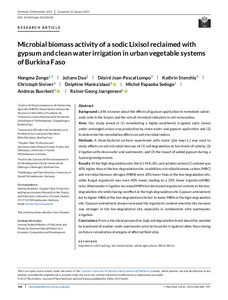| dc.date.accessioned | 2023-04-20T06:54:43Z | |
| dc.date.available | 2023-04-20T06:54:43Z | |
| dc.date.issued | 2023-02-13 | |
| dc.identifier | doi:10.17170/kobra-202304207846 | |
| dc.identifier.uri | http://hdl.handle.net/123456789/14603 | |
| dc.description.sponsorship | Gefördert im Rahmen des Projekts DEAL | ger |
| dc.language.iso | eng | |
| dc.rights | Attribution-NonCommercial-NoDerivatives 4.0 International | * |
| dc.rights.uri | http://creativecommons.org/licenses/by-nc-nd/4.0/ | * |
| dc.subject | ergosterol | eng |
| dc.subject | salt leaching | eng |
| dc.subject | soil remediation | eng |
| dc.subject | urban agriculture | eng |
| dc.subject | West Africa | eng |
| dc.subject.ddc | 570 | |
| dc.subject.ddc | 630 | |
| dc.title | Microbial biomass activity of a sodic Lixisol reclaimed with gypsum and clean water irrigation in urban vegetable systems of Burkina Faso | eng |
| dc.type | Aufsatz | |
| dcterms.abstract | Background: Little is known about the effects of gypsum application to remediate saline-sodic soils in the tropics and the role of microbial indicators in soil reclamation. Aims: Our study aimed at (1) remediating a highly weathered, irrigated sodic Lixisol under prolonged urban crop production by clean water and gypsum application and (2) to determine the remediation effects on soil microbial indices. Methods: A three-factorial on-farm experiment with maize (Zea mays L.) was used to study effects on soil microbial biomass of (1) soil degradation at two levels of salinity, (2) irrigation with clean water and wastewater, and (3) the impact of added gypsum during a typical growing season. Results: At the high-degradation site, the 0.5 M K 2 SO4 extractable carbon (C) content was 40% higher than at the low-degradation site. In addition, microbial biomass carbon (MBC) and microbial biomass nitrogen (MBN) were 20% lower than at the low-degradation site, while fungal ergosterol was even 40% lower, leading to a 33% lower ergosterol/MBC ratio. Wastewater irrigation increased MBN but decreased ergosterol content at the low-degradation site while having no effect at the high-degradation site. Gypsum amendment led to higher MBN at the low-degradation site but to lower MBN at the high-degradation site. Gypsum amendment always increased the ergosterol content whereby this increase was stronger at the low-degradation site, especially in combination with wastewater irrigation. Conclusions: From a microbial perspective, high soil degradation levels should be avoided by treatment of a saline–sodic wastewater prior to its use for irrigation rather than relying on future remediation strategies of affected field sites. | eng |
| dcterms.accessRights | open access | |
| dcterms.creator | Zongo, Nongma | |
| dcterms.creator | Dao, Julia | |
| dcterms.creator | Lompo, Désiré Jean-Pascal | |
| dcterms.creator | Stenchly, Kathrin | |
| dcterms.creator | Steiner, Christoph | |
| dcterms.creator | Manka’abusi, Delphine | |
| dcterms.creator | Sedogo, Michel Papaoba | |
| dcterms.creator | Bürkert, Andreas | |
| dcterms.creator | Jörgensen, Rainer Georg | |
| dcterms.extent | 188-195 | |
| dc.relation.doi | doi:10.1002/jpln.202200418 | |
| dc.subject.swd | Westafrika | ger |
| dc.subject.swd | Burkina Faso | ger |
| dc.subject.swd | Bewässerung | ger |
| dc.subject.swd | Biomasse | ger |
| dc.subject.swd | Städtische Landwirtschaft | ger |
| dc.subject.swd | Ergosterin | ger |
| dc.subject.swd | Bodensanierung | ger |
| dc.type.version | publishedVersion | |
| dcterms.source.identifier | eissn:1522-2624 | |
| dcterms.source.issue | Issue 2 | |
| dcterms.source.journal | Journal of Plant Nutrition and Soil Science | eng |
| dcterms.source.volume | Volume 186 | |
| kup.iskup | false | |


